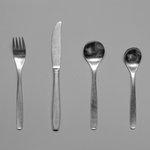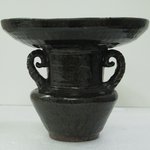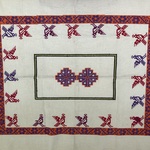
Vase
Harada Shuroku
Asian Art
Harada Shūroku trained with the masters of the Bizen kilns, making mostly unglazed, dark-red wares that have scorch patterns as their primary decoration. This vase is in his most experimental style, which he calls ranbari, a Japanese carpentry term for wood flooring composed of boards of various sizes laid down in random order. He creates a relatively smooth and conventional ceramic form, then applies patches of very rough clay to the outside in a meandering grid that resembles a stone wall.
MEDIUM
Bizen ware: unglazed stoneware
DATES
ca. 2006
PERIOD
Heisei Period
DIMENSIONS
11 x 6 5/16 in. (28 x 16 cm) (show scale)



INSCRIPTIONS
On side of storage box, in Japanese:
Bizen rancho hanaire (Bizen "randomly pulled" patterned vase)
Signed:
Shuroku
Sealed:
Shu
COLLECTIONS
Asian Art
ACCESSION NUMBER
2014.60.5
CREDIT LINE
Gift of Steven Korff and Marcia Van Wagner
CATALOGUE DESCRIPTION
Harada Shuroku
(Japanese, born 1941)
Vase, circa 2006
Bizen ware: unglazed stoneware
Gift of Steven Korff and Marcia Van Wagner, 2014.60.5
Harada Shuroku trained with the masters of the Bizen kilns, making mostly unglazed, dark-red wares that have scorch patterns as their primary decoration. This vase is in his most experimental style, which he calls ranbari, a Japanese carpentry term for wood flooring composed of boards of various sizes laid down in random order. He creates a relatively smooth and conventional ceramic form, then applies patches of very rough clay to the outside in a meandering grid that resembles a stone wall.
(Label by Joan Cummins, October 2019, for Arts of Japan gallery)
MUSEUM LOCATION
This item is not on view
CAPTION
Harada Shuroku (Japanese, born 1941). Vase, ca. 2006. Bizen ware: unglazed stoneware, 11 x 6 5/16 in. (28 x 16 cm). Brooklyn Museum, Gift of Steven Korff and Marcia Van Wagner, 2014.60.5. Creative Commons-BY (Photo: , 2014.60.5_front_PS9.jpg)
IMAGE
front, 2014.60.5_front_PS9.jpg., 2019
"CUR" at the beginning of an image file name means that the image was created by a curatorial staff member. These study images may be digital point-and-shoot photographs, when we don\'t yet have high-quality studio photography, or they may be scans of older negatives, slides, or photographic prints, providing historical documentation of the object.
RIGHTS STATEMENT
Creative Commons-BY
You may download and use Brooklyn Museum images of this three-dimensional work in accordance with a Creative Commons license. Fair use, as understood under the United States Copyright Act, may also apply.
Please include caption information from this page and credit the Brooklyn Museum. If you need a high resolution file, please fill out our online application form (charges apply).
For further information about copyright, we recommend resources at the United States Library of Congress, Cornell University, Copyright and Cultural Institutions: Guidelines for U.S. Libraries, Archives, and Museums, and Copyright Watch.
For more information about the Museum's rights project, including how rights types are assigned, please see our blog posts on copyright.
If you have any information regarding this work and rights to it, please contact copyright@brooklynmuseum.org.
RECORD COMPLETENESS
Not every record you will find here is complete. More information is available for some works than for others, and some entries have been updated more recently. Records are frequently reviewed and revised, and we welcome any additional information you might have.





















